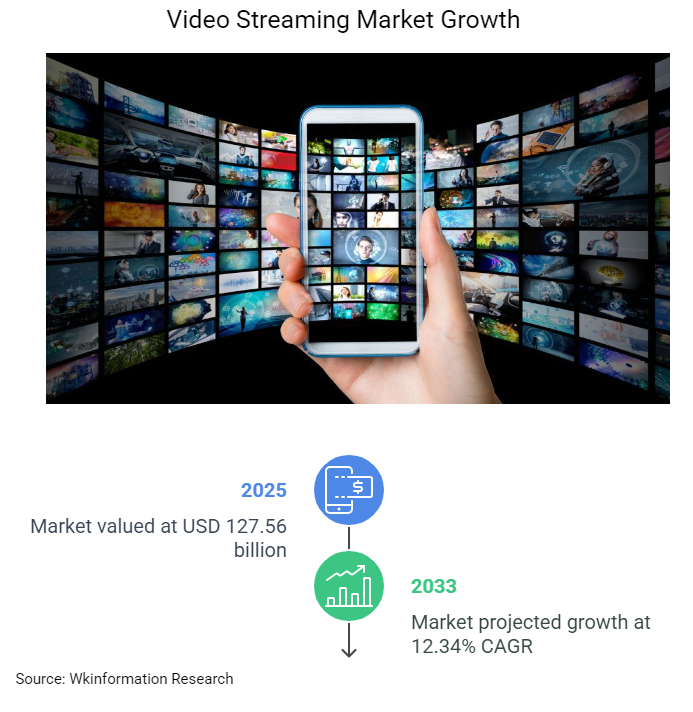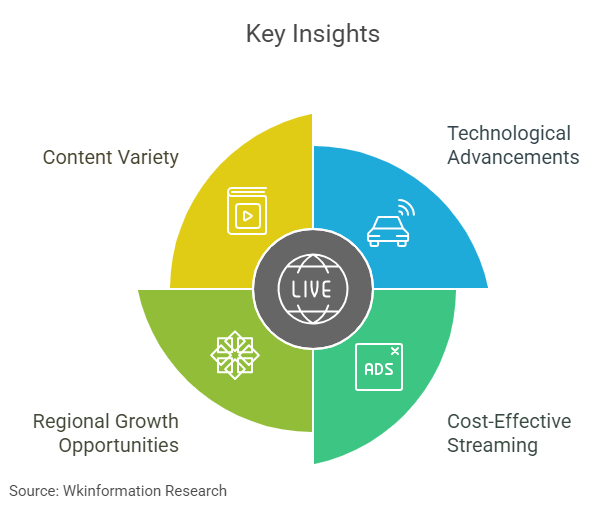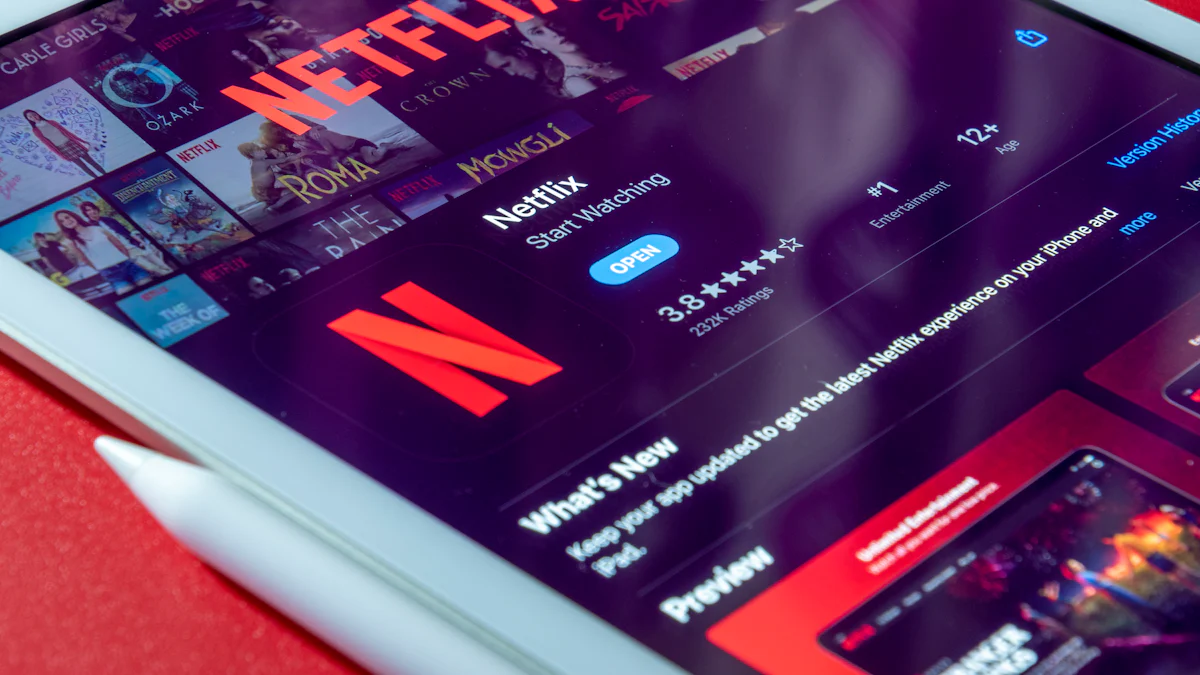
The video streaming market continues to expand at an unprecedented pace, fueled by technological advancements and shifting consumer preferences. The global market size, valued at USD 127.56 billion in 2025, is projected to grow at a compound annual growth rate (CAGR) of 12.34% from 2025 to 2033. Emerging technologies like AI and cloud-based solutions are transforming streaming experiences by enabling personalized recommendations and improving content delivery. In regions like Asia and Latin America, factors such as affordable services, collaborations with telecom operators, and increasing internet penetration are driving a surge in OTT viewership. These key trends in streaming highlight the industry’s dynamic evolution and its ability to cater to diverse audiences.
Key Insights
- The global video streaming market is worth USD 127.56 billion in 2025. It is expected to grow by 12.34% each year until 2033. This growth is due to new technology and changing viewer habits.
- AI and 5G are improving streaming by making it better. They help create personalized content and improve video quality. Users can watch high-quality videos without interruptions.
- Free or low-cost streaming with ads is becoming popular. It attracts people who want to save money while earning money through ads.
- Countries in Asia and Latin America offer big chances for growth. More people are using the internet and mobile phones in these areas.
- Streaming platforms need to offer more variety to stay popular. They should focus on user-friendly ideas like local content and personal suggestions.

Market Overview
Market Size and Growth
Current valuation and projected growth rates
The video streaming market has experienced remarkable growth in recent years. Valued at USD 127.56 billion in 2025, it is projected to grow at a compound annual growth rate (CAGR) of 12.34% from 2025 to 2033. This rapid expansion highlights the increasing demand for streaming services globally, driven by technological advancements and evolving consumer preferences.
Key drivers of market expansion
Several factors contribute to the growth of the video streaming industry:
- Extensive growth of online video streaming.
- Rising demand for on-demand streaming.
- Growing demand for high-speed internet connectivity.
- Increasing adoption of cloud-based solutions.
- Technological advancements enhancing video quality and performance.
- A surge in viewership during the COVID-19 pandemic, with a 10% increase during lockdowns.
These drivers underscore the dynamic nature of the streaming market and its ability to adapt to changing consumer needs.
Product Types
Subscription-based video-on-demand (SVOD)
SVOD platforms, such as Netflix and Disney+, dominate the market by offering subscription services that provide unlimited access to content for a recurring fee. These platforms attract subscribers by investing heavily in original programming and exclusive content.
Ad-supported video-on-demand (AVOD)
AVOD models, like YouTube and Tubi, provide free content supported by advertisements. This approach appeals to cost-conscious viewers and generates revenue through ad placements.
Live streaming services
Live streaming services cater to real-time content consumption, including live sports, concerts, and events. Platforms like Twitch and Facebook Live have gained popularity by enabling interactive experiences and fostering community engagement.
Applications
Entertainment and media
Entertainment remains the primary application of video streaming platforms. Consumers rely on these platforms for movies, TV shows, and live events, driving significant revenue for the industry.
Education and e-learning
Streaming services have revolutionized education by providing access to online courses, tutorials, and webinars. Platforms like Coursera and Khan Academy enable learners to access high-quality content from anywhere.
Corporate and enterprise use cases
Businesses utilize streaming platforms for virtual meetings, training sessions, and webinars. These services enhance communication and collaboration, especially in remote work environments.
Key Streaming Trends

Technological Advancements
AI in content personalization
Artificial intelligence plays a pivotal role in enhancing user experience on streaming platforms. By leveraging AI, platforms like Netflix utilize hybrid recommendation models that combine collaborative filtering, content-based filtering, and deep learning to deliver personalized suggestions. Prime Video employs natural language processing (NLP) to analyze user behavior and reviews, tailoring homepage carousels to individual preferences. Similarly, YouTube refines its recommendation engine through deep learning algorithms, optimizing video suggestions based on user interactions. These advancements ensure that streaming services cater to diverse tastes, fostering increased engagement and viewership.
5G’s impact on streaming quality
The advent of 5G technology has revolutionized the video streaming market by significantly improving user experience. Faster internet speeds enable seamless streaming of high-definition and 4K content with minimal buffering, even in crowded areas. The low latency of 5G enhances real-time content delivery, making it ideal for live sports streaming and other time-sensitive events. This technological leap transforms how users consume video content, ensuring uninterrupted access to high-quality streaming services.
Content Trends
Growth of live sports streaming
Live sports streaming continues to dominate the streaming market, reshaping consumer habits and driving a surge in OTT viewership. By 2027, 40% of sports viewership is projected to come from live streaming platforms. Live sports events account for 70% of peak internet traffic, reflecting their immense popularity. Additionally, viewers spend 57% more time watching live sports on streaming platforms compared to traditional TV. These trends highlight the growing demand for real-time sports content and its role in boosting revenue for streaming services.
Rise of niche platforms
Niche platforms are carving out a unique space in the streaming market by targeting specific audiences. These platforms differentiate themselves by focusing on specialized content that resonates with their viewers. For instance, they maintain engagement by offering familiar content between major releases. By clearly defining their target audience, niche platforms compete effectively with larger streaming services, contributing to the diversity of the video streaming landscape.
Business Models
Ad-supported and hybrid models
Ad-supported free streaming and hybrid models are gaining traction as platforms seek to diversify revenue streams. The hybrid video-on-demand (HVOD) model combines subscription tiers with personalized ads, catering to a broader audience. Offering flexible pricing options attracts users hesitant to commit to full subscriptions. However, transitioning to ad-supported models poses challenges, as users accustomed to ad-free experiences may find the shift disruptive. Platforms must strike a balance to retain loyalty while expanding their user base.
Consumer-Centric Innovations
Interactive and immersive content
Interactive and immersive content is revolutionizing the video streaming landscape by offering viewers engaging and dynamic experiences. Augmented reality (AR) allows users to interact with content in real time, such as selecting camera angles during movies or viewing song lyrics at concerts. Virtual reality (VR) takes storytelling to the next level by immersing viewers in real-life or fictional scenarios. For instance, BBC News’s VR documentary on the refugee crisis provides a deeply impactful experience.
Streaming platforms are also leveraging 360-degree video to create a sense of presence during live events. This technology enables viewers to feel like part of the audience at music festivals or sports games. Supporting these innovations, 5G networks ensure ultra-low latency and high bandwidth, enabling seamless streaming of high-resolution immersive content. Edge computing further enhances streaming quality by processing data closer to users, reducing delays and improving responsiveness. These advancements not only elevate viewership but also open new revenue streams for platforms by attracting tech-savvy audiences.
Multi-device and cross-platform compatibility
Multi-device and cross-platform compatibility has become a cornerstone of modern streaming trends. By ensuring a consistent experience across devices, streaming platforms significantly enhance user satisfaction and engagement. Users can seamlessly switch between smartphones, tablets, smart TVs, and desktops without losing functionality or quality. This flexibility caters to the growing demand for convenience in OTT services.
Platforms that develop applications with a single codebase simplify updates and bug fixes, ensuring a smoother user experience. Cross-platform solutions also unlock diverse monetization opportunities, maximizing revenue potential for streaming services. As streaming trends evolve, this compatibility remains essential for retaining viewership and maintaining a competitive edge in the market.
Regional Insights

North America
Market maturity and leading players
North America represents a mature video streaming market, driven by several factors:
- Extensive growth of online video streaming.
- Rising demand for on-demand streaming.
- Growing adoption of high-speed internet connectivity.
- Increasing use of mobile devices and tablets.
- Rapid technological advancements and cloud-based solutions.
Leading platforms such as Netflix, Amazon Prime Video, and Disney+ dominate the region. Their success stems from investments in original content, advanced recommendation algorithms, and partnerships with telecom providers. These strategies ensure sustained viewership and revenue growth.
Subscription saturation trends
Subscription saturation has become a challenge in North America. Many households now subscribe to multiple services, leading to market saturation. As a result, platforms are exploring hybrid models and ad-supported tiers to attract cost-conscious users. This shift reflects the need for innovation in a competitive landscape.
Europe
Localized content production
Streaming platforms in Europe prioritize localized content to capture diverse audiences. Investments include language options and region-specific shows and movies.
Localized content strengthens cultural connections and boosts viewership, ensuring platforms remain relevant in a competitive market.
Regulatory impacts
European regulations, such as the EU’s Audiovisual Media Services Directive, require platforms to allocate 30% of their catalogs to European content. This policy encourages investment in local productions but also increases operational costs for global players. Platforms must balance compliance with profitability to thrive in the region.
Asia-Pacific
Growth in emerging markets
Asia-Pacific is experiencing rapid growth in video streaming, driven by factors such as:
| Driver of Growth | Description |
|---|---|
| Growing adoption of cloud-based solutions | Increased reliance on cloud technology for video streaming services. |
| Increasing use of smartphones | Higher smartphone penetration with access to high-speed internet (3G, 4G, LTE) enhances streaming. |
Emerging markets like India and Indonesia are pivotal to this growth. Affordable OTT services and collaborations with telecom operators further boost adoption.
Mobile-first consumer behavior
Mobile-first consumer behavior dominates the Asia-Pacific market. Consumers prefer streaming on smartphones and tablets due to convenience and accessibility. Localized content and personalized recommendations enhance the appeal of mobile streaming, catering to diverse audiences. This trend underscores the region’s unique consumer preferences and its potential for sustained growth.
Latin America
Affordable streaming options
Latin America has emerged as a key region for the growth of video streaming. Affordable pricing strategies adopted by streaming platforms have played a crucial role in attracting a diverse audience. Many platforms offer tiered subscription models, enabling users to choose plans that suit their budgets. Additionally, partnerships with telecom providers have introduced bundled packages, making streaming services more accessible to cost-conscious consumers. These initiatives have significantly boosted viewership across the region.
The rise of ad-supported models has further expanded the reach of streaming platforms. By offering free or low-cost access to content, these models cater to users who may not afford premium subscriptions. This approach not only increases user engagement but also generates revenue through targeted advertisements. As a result, streaming platforms continue to gain traction in Latin America, solidifying their presence in the market.
Internet penetration driving growth
The rapid increase in internet penetration has transformed the video streaming landscape in Latin America. High-speed internet access has become more widespread, enhancing the ability of users to stream content seamlessly. This development has benefited home users, educational institutions, and businesses alike. As internet connectivity improves, consumer preferences have shifted toward on-demand content, driving the adoption of streaming services.
The growing popularity of online shows and live events has further fueled this trend. With more users gaining access to reliable internet, streaming platforms have tapped into previously underserved regions. This expansion has created significant opportunities for growth, enabling platforms to reach new audiences and increase viewership. Latin America’s evolving digital infrastructure continues to shape the future of the streaming market.
Middle East and Africa
Opportunities in underpenetrated markets
The Middle East and Africa represent untapped potential for video streaming platforms. These regions have a large population of young, tech-savvy individuals eager to explore digital entertainment. Streaming platforms can capitalize on this demographic by offering localized content that resonates with cultural preferences. Collaborations with regional creators and broadcasters can further enhance the appeal of these services.
The demand for live content, such as sports and music events, presents another growth avenue. By focusing on real-time streaming, platforms can attract audiences seeking interactive and engaging experiences. The introduction of affordable subscription plans and ad-supported models can also help platforms penetrate these underdeveloped markets. As a result, the Middle East and Africa hold immense promise for the future of streaming.
Infrastructure challenges
Despite the opportunities, infrastructure challenges remain a significant barrier to the growth of video streaming in the Middle East and Africa. Limited access to high-speed internet and inconsistent network coverage hinder the ability of users to stream content effectively. In rural areas, the lack of reliable connectivity further exacerbates the issue.
Streaming platforms must address these challenges by investing in infrastructure development and partnering with telecom providers. Initiatives such as offline viewing options and data-efficient streaming technologies can also mitigate the impact of poor connectivity. By overcoming these obstacles, platforms can unlock the full potential of these regions and expand their reach.
Consumer Behavior and Preferences
Adoption Rates
Demographic trends
Streaming adoption varies significantly across demographic groups, reflecting diverse consumer trends. Younger generations, such as Gen Z and Millennials, exhibit higher rates of subscription cancellations and renewals compared to older groups.
Additionally, many consumers have switched to free ad-supported streaming platforms to save money. This shift underscores the growing appeal of cost-effective options in the video streaming market.
Pandemic’s impact on habits
The COVID-19 pandemic significantly influenced streaming adoption and consumer trends. Many individuals turned to streaming platforms as traditional entertainment venues closed. Viewers increasingly sought self-help videos to learn new skills and alleviate stress. Feel-good content, such as animal videos and self-care tutorials, gained popularity. Online communities also flourished, enabling people to connect over shared interests during lockdowns. These changes highlight the pandemic’s role in reshaping viewership patterns.
Device Usage
Mobile dominance in emerging markets
Mobile devices dominate streaming adoption in emerging markets due to their affordability and accessibility. Consumers in regions like Asia and Latin America prefer smartphones for video streaming, driven by mobile-first behavior and high-speed internet availability. Streaming platforms cater to this trend by optimizing their services for mobile devices, ensuring seamless user experiences.
Growth of smart TVs
Smart TVs have emerged as a preferred device for video streaming, driven by their affordability and enhanced features. Many models now come with pre-installed streaming apps, making them convenient for households. The demand for larger screens and high-quality displays, such as 4K and OLED, has further fueled their popularity. Urbanization and rising disposable incomes have also contributed to the growth of smart TVs, particularly in regions with robust internet infrastructure.
Subscription Trends
Multi-subscription households
Multi-subscription households have become a defining feature of the video streaming landscape. In 2023, 83% of U.S. households subscribed to at least one streaming service, with an average of 4.1 subscriptions per household. This trend reflects the growing demand for diverse content and the willingness of subscribers to invest in multiple platforms. However, many consumers express interest in bundled services to simplify subscription management and reduce costs.
Churn rates and loyalty factors
Churn rates remain a challenge for streaming platforms as consumers frequently switch services. Factors such as pricing, content availability, and user experience influence loyalty. Platforms must focus on personalized recommendations and flexible pricing models to retain subscribers. Additionally, ease of content discovery plays a crucial role in maintaining viewership and reducing churn.
Competitive Landscape
Major Players
- Brightcove Inc.
- Limelight Networks
- Haivision Inc.
- Google LLC
- IBM Corporation
- Kaltura
- Amazon Inc.
- Cisco Systems Inc.
- Ooyala
- Akamai Technologies
Emerging Competitors
Niche and independent platforms
Niche streaming platforms are carving out a distinct space in the market by targeting specific audiences. These services focus on specialized content, such as documentaries, anime, or independent films, which larger platforms may overlook. By catering to dedicated fan bases, niche platforms foster loyalty and consistent viewership. Their ability to deliver unique experiences positions them as valuable alternatives to mainstream streaming services.
Tech giants entering the market
Technology companies are entering the video streaming industry, leveraging their resources and expertise to disrupt the market. For instance, Apple TV+ and Google-owned YouTube Premium offer competitive pricing and exclusive content to attract subscribers. These tech giants utilize their existing ecosystems to enhance user convenience, such as integrating streaming services with hardware like smartphones and smart TVs. Their entry intensifies competition and drives innovation across the industry.
Partnerships and Collaborations
Content licensing deals
Content licensing agreements play a pivotal role in expanding the reach of streaming platforms. Netflix’s partnership with Microsoft enhances its content delivery through the Microsoft Cloud, ensuring scalability and improved service quality. Similarly, Warner Bros. Discovery collaborates with Amazon to make HBO Max available on Amazon Prime Video Channels. These partnerships enable platforms to reach wider audiences while optimizing operational efficiency.
Alliances with telecom providers
Collaborations with telecom providers have become a key strategy for streaming platforms to increase accessibility. Bundled subscription packages offered by telecom companies make streaming services more affordable for consumers. These alliances also improve content delivery by leveraging telecom infrastructure, particularly in regions with limited internet connectivity. Such partnerships contribute to the growth of streaming platforms in emerging markets.
Future Outlook
Innovations on the Horizon
AR/VR integration
Augmented reality (AR) and virtual reality (VR) are set to redefine the video streaming market by offering immersive and interactive experiences. Spatial streaming allows content to adapt to physical spaces, enhancing the realism of AR and VR applications. Users can interact with virtual objects and environments in real time, creating a more engaging viewing experience. For instance, viewers can explore 3D models or watch content on virtual screens within their surroundings, seamlessly merging digital content with reality. These advancements promise to elevate viewership by providing unique and personalized experiences, positioning AR/VR as a transformative force in the streaming market.
Blockchain for content security
Blockchain technology offers unparalleled security and transparency for video streaming platforms. Each video stream functions as a verifiable transaction, giving content creators and businesses complete control over their digital assets. Blockchain also enhances user data security by distributing information across the network, reducing vulnerabilities to hacking and breaches. Advanced cryptographic techniques ensure privacy, while unique digital fingerprints for each video prevent unauthorized copying and distribution. These features not only protect intellectual property but also build trust among users, fostering a secure and reliable streaming ecosystem.
Market Shifts
Sustainability in operations
Sustainability is becoming a critical focus for the video streaming industry. Platforms are adopting energy-efficient technologies to reduce their carbon footprint, such as optimizing data centers and employing renewable energy sources. Streaming services are also exploring eco-friendly practices, including reducing bandwidth usage through advanced compression techniques. These efforts align with global trends toward environmental responsibility, ensuring that the industry remains sustainable while meeting consumer demands.
Evolution of pricing models
The evolution of pricing models is reshaping the streaming market. Platforms are introducing tiered subscription plans and hybrid models to cater to diverse audiences. Ad-supported tiers offer affordable options for cost-conscious users, while premium plans provide ad-free experiences and exclusive content. This flexibility enhances user satisfaction and broadens the appeal of streaming services. By adapting pricing strategies to consumer preferences, platforms can maintain competitiveness and drive growth in a saturated market.
Challenges and Opportunities
Addressing content saturation
Content saturation poses a significant challenge for streaming platforms. Diversifying content offerings has proven effective, with services like Prime Video and Peacock incorporating live news and sports to attract viewers. Subscriber satisfaction has increased with these additions, reflecting the growing demand for varied content. Platforms must also analyze subscriber data to understand perceptions of value and improve personalization. By focusing on content depth and user experience, streaming platforms can combat churn and sustain viewership.
Expanding into untapped markets
Untapped markets present immense opportunities for the video streaming industry. Regions with low streaming penetration, such as parts of Africa and the Middle East, offer significant growth potential. Platforms can capitalize on these opportunities by offering localized content and affordable subscription plans. Collaborations with telecom providers can further enhance accessibility, enabling platforms to reach new audiences. By addressing infrastructure challenges and tailoring services to regional needs, the industry can unlock new avenues for expansion.
Conclusion
The video streaming market continues to evolve at a remarkable pace, driven by advancements in technology and shifting consumer preferences. AI and 5G have transformed streaming experiences, while ad-supported models have expanded access to diverse audiences. Subscription-based services remain a cornerstone of the industry, but platforms must address challenges like content saturation to sustain growth. Regional markets, particularly in Asia and Latin America, offer significant opportunities for expansion. The dynamic nature of streaming ensures ongoing innovation, positioning the industry for sustained success and global impact.
| Report Metric | Details |
|---|---|
| Report Name | Global Video Streaming Market Report |
| Base Year | 2024 |
| Segment by Type |
· Subscription-based video-on-demand (SVOD) · Ad-supported video-on-demand (AVOD) · Live streaming services |
| Segment by Application |
· Entertainment and media · Education and e-learning · Corporate and enterprise use cases |
| Geographies Covered |
· North America (United States, Canada) · Europe (Germany, France, UK, Italy, Russia) · Asia-Pacific (China, Japan, South Korea, Taiwan) · Southeast Asia (India) · Latin America (Mexico, Brazil) |
| Forecast units | USD million in value |
| Report coverage | Revenue and volume forecast, company share, competitive landscape, growth factors and trends |
FAQ
What is driving the growth of the video streaming market?
The market’s growth stems from technological advancements, such as AI and 5G, and shifting consumer preferences. Increasing internet penetration, mobile-first behavior, and the demand for on-demand content also contribute significantly. Emerging markets like Asia and Latin America play a pivotal role in this expansion.
How does AI enhance video streaming experiences?
AI improves user experiences by personalizing content recommendations. Platforms like Netflix and YouTube use AI algorithms to analyze user behavior and preferences. This technology ensures viewers receive tailored suggestions, increasing engagement and satisfaction.
Why are ad-supported models gaining popularity?
Ad-supported models attract cost-conscious users by offering free or low-cost access to content. These models generate revenue through targeted advertisements, making them a viable alternative to subscription-based services. They also expand the audience base for streaming platforms.
What challenges do streaming platforms face in emerging markets?
Infrastructure challenges, such as inconsistent internet connectivity and limited access to high-speed networks, hinder growth. Platforms must invest in data-efficient technologies and collaborate with telecom providers to overcome these barriers and reach underserved regions.
How are streaming platforms addressing content saturation?
Platforms diversify their offerings by including live sports, news, and niche content. They also use data analytics to personalize recommendations and improve user experiences. These strategies help retain subscribers and reduce churn rates.
Global Video Streaming Market Report (Can Read by Free sample) – Table of Contents
Chapter 1: Video Streaming Market Analysis Overview
- Competitive Forces Analysis (Porter’s Five Forces)
- Strategic Growth Assessment (Ansoff Matrix)
- Industry Value Chain Insights
- Regional Trends and Key Market Drivers
- Video StreamingMarket Segmentation Overview
Chapter 2: Competitive Landscape
- Global Video Streamingplayers and Regional Insights
- Key Players and Market Share Analysis
- Sales Trends of Leading Companies
- Year-on-Year Performance Insights
- Competitive Strategies and Market Positioning
- Key Differentiators and Strategic Moves
Chapter 3: Video Streaming Market Segmentation Analysis
- Key Data and Visual Insights
- Trends, Growth Rates, and Drivers
- Segment Dynamics and Insights
- Detailed Market Analysis by Segment
Chapter 4: Regional Market Performance
- Consumer Trends by Region
- Historical Data and Growth Forecasts
- Regional Growth Factors
- Economic, Demographic, and Technological Impacts
- Challenges and Opportunities in Key Regions
- Regional Trends and Market Shifts
- Key Cities and High-Demand Areas
Chapter 5: Video Streaming Emerging and Untapped Markets
- Growth Potential in Secondary Regions
- Trends, Challenges, and Opportunities
Chapter 6: Product and Application Segmentation
- Product Types and Innovation Trends
- Application-Based Market Insights
Chapter 7: Video Streaming Consumer Insights
- Demographics and Buying Behaviors
- Target Audience Profiles
Chapter 8: Key Findings and Recommendations
- Summary ofVideo StreamingMarket Insights
- Actionable Recommendations for Stakeholders


